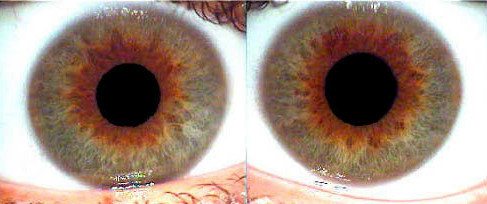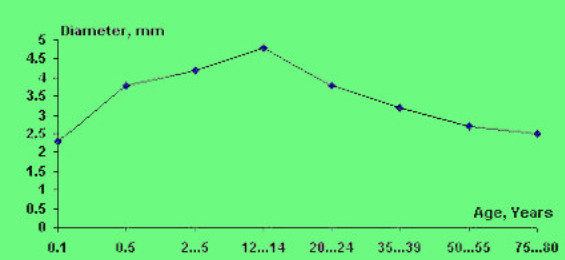The color of the pupil is influenced by the condition of the lens and the anterior chamber of the eye. Changes in these structures often reflect underlying issues within the body’s functional systems, such as the endocrine or vascular systems. Any deviation in the pupil’s color from the typical black is considered a sign of pathological change.

Normal Pupil Color
The most common cause of a loss of the normal black color in the pupil is cataract. In such cases, the pupil’s color may range from muddy gray to bright white, exhibiting various patterns such as a general whitish tint, isolated sub-capsular patches, central dots, radial streaks, or sector-shaped bands. These changes can also be accompanied by alterations in the iris color under side illumination.
Dimensions of the pupil
This curve illustrates how the pupil diameter changes with age.
Under normal conditions, the pupil diameter ranges from 2.7 to 4.8 mm in the dark (22.5% to 40% of the iris diameter), with an average size of 3.5 mm (approximately 29% of the iris diameter). In newborns, pupils are naturally smaller, averaging 2.32 ± 0.05 mm, which is 19-20% of the iris diameter. From the second month of life, pupil size gradually increases, growing by about 64% by six months and an additional 8.6% by the first year. This growth continues until around the tenth or eleventh year. Between ages 10 and 14, the pupils start to shrink, with three distinct phases observed:
- In the first phase (15 to 24 years), the pupil diameter decreases significantly by 17-19%.
- In the second phase (25 to 50 years), the narrowing slows, with a reduction of about 6-9% every five years.
- In the third phase (50 to 80 years), the pupils remain relatively small at around 2.63 ± 0.06 mm (about 22% of the iris diameter), experiencing a slower decrease of 3-4% every decade.
Pupil tension or relaxation is regulated by the central nervous system. A relaxed pupil with poor tone may indicate overall body fatigue, while a constricted pupil reflects bodily tension. Pupil tonus is managed by the central and autonomic nervous systems, with dilation and contraction influenced by physical and emotional factors such as fear, pain, excitement, boredom, and fatigue.
Understanding the changes in pupil size with aging helps in differentiating between physiological and pathological forms of miosis and mydriasis.

